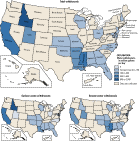
 |
Estimated Use of Water in the United States in 2000
Aquaculture
Aquaculture water use is water associated with raising organisms that live in water—such as finfish and shellfish—for food, restoration, conservation, or sport. Aquaculture production occurs under controlled feeding, sanitation, and harvesting procedures primarily in ponds, flow-through raceways, and, to a lesser extent, cages, net pens, and closed-recirculation tanks. All withdrawals were considered self-supplied. Only freshwater withdrawals were compiled as part of the total. Aquaculture combines the fish-farming activities of the former livestock subcategory animal specialties and the fish-hatchery activities of the commercial category that were reported during 1990 and 1995 (Solley and others, 1993, 1998, respectively). For 2000, consumptive use was not reported for aquaculture.
For 2000, the estimate of aquaculture water use for the United States was based on estimates of freshwater withdrawals for aquaculture in 19 States, rather than on estimates from all States. These 19 States included the 8 States with the largest water withdrawals for animal specialties in 1995, and 11 other States in which aquaculture water-use data were collected as part of a broader State water-use program for 2000. Most of the water withdrawals for animal specialties during 1995 were for aquaculture, with a small amount of water primarily used for watering horses. The 19 States that reported for 2000 accounted for 94 percent of the total withdrawals for animal-specialties water use during 1995. During 1995, withdrawals for animal specialties accounted for a small percentage of the total water use, less than 1 percent of the total withdrawals for all categories.
Freshwater withdrawals for aquaculture for 2000 are listed by State in table 9. ![]() For 2000, the quantity of freshwater withdrawn for aquaculture was an estimated 3,700 Mgal/d, or 4,150 thousand acre-feet per year. Maryland reported saline withdrawals of 3.09 Mgal/d, which are not listed in the tables or included in the totals. Surface water was the source for about 71 percent of the withdrawals for this category. Aquaculture withdrawals were nearly 1 percent of total water withdrawals and nearly 2 percent of total withdrawals for all categories excluding thermoelectric power.
For 2000, the quantity of freshwater withdrawn for aquaculture was an estimated 3,700 Mgal/d, or 4,150 thousand acre-feet per year. Maryland reported saline withdrawals of 3.09 Mgal/d, which are not listed in the tables or included in the totals. Surface water was the source for about 71 percent of the withdrawals for this category. Aquaculture withdrawals were nearly 1 percent of total water withdrawals and nearly 2 percent of total withdrawals for all categories excluding thermoelectric power.
The geographic distribution of total, surface-water, and ground-water withdrawals for aquaculture is shown in figure 9.  Idaho used the most water for aquaculture, about one-half of the total reported. Idaho's source of water was almost exclusively surface water, and represented 73 percent of the total surface-water withdrawals for aquaculture. Mississippi, Arkansas, California, Louisiana, and Utah combined accounted for 86 percent of the ground-water withdrawals for aquaculture.
Idaho used the most water for aquaculture, about one-half of the total reported. Idaho's source of water was almost exclusively surface water, and represented 73 percent of the total surface-water withdrawals for aquaculture. Mississippi, Arkansas, California, Louisiana, and Utah combined accounted for 86 percent of the ground-water withdrawals for aquaculture.
Several sources of information were used to estimate withdrawals for aquaculture. Some estimates of aquaculture water use were derived from State permits that reported water withdrawals or return flows for aquaculture facilities. The USEPA Permit Compliance System database also was a source of return-flow data that were used to estimate water withdrawals. The State Offices of the USDA National Agricultural Statistics Service or the Cooperative Extension Service sometimes maintained records for a State on pond acreage for fish farms and sometimes on the rate of water lost to evaporation for the ponds.
Water Use in the United States | USGS Water Resources of the United States
For more information: wu-info@usgs.gov